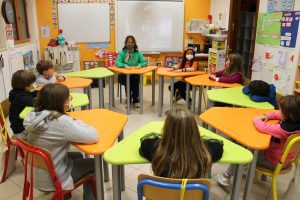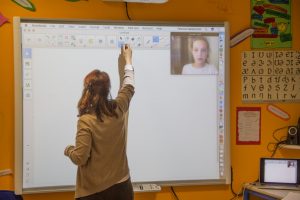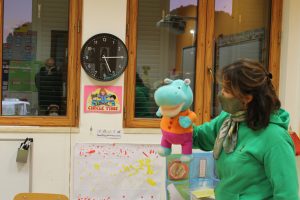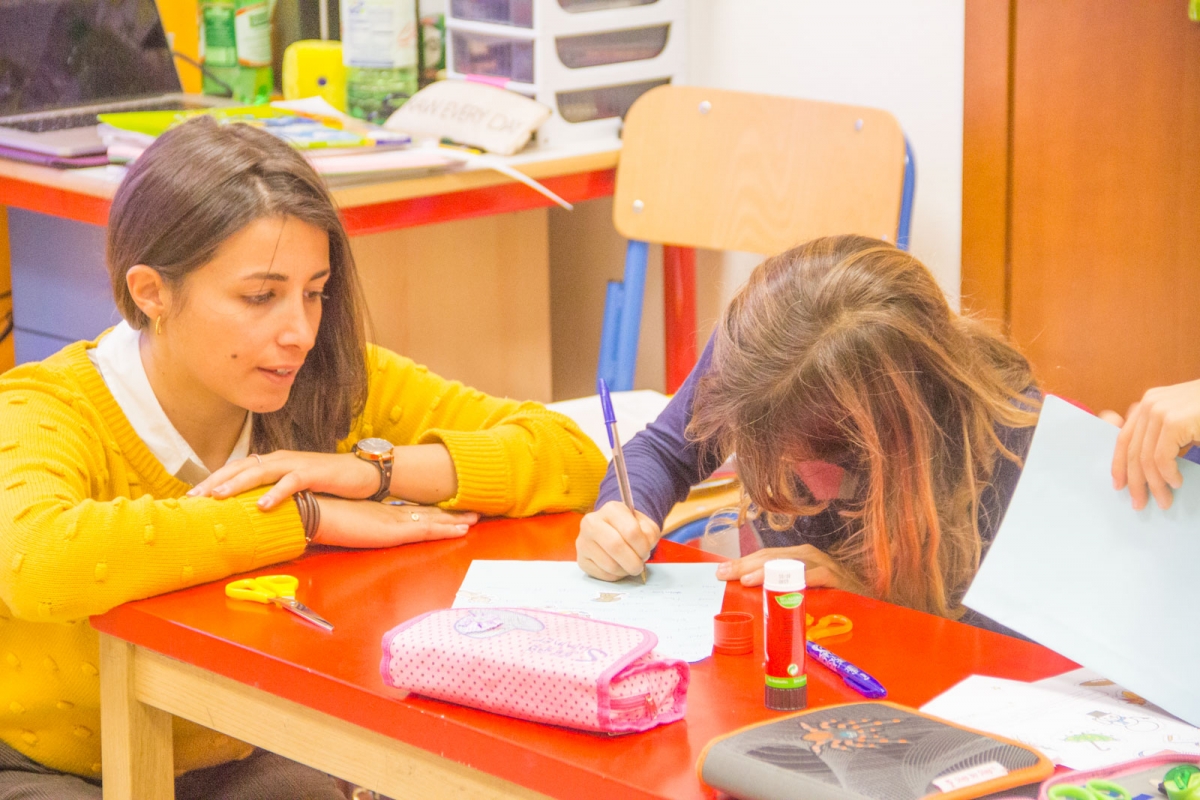by Jori Diego Cherubini
This story arise from Patricia’s own original reflections ̶ she is an Italo-Argentinian teacher who founded Creating Connections, a school based in Montalcino where you can learn to read, speak and think in English (and not only). In 2001, after years of experience, Patricia brought her innovative idea of education to the Val d’Orcia, with the motto of ‘have fun learning’. The classrooms are colourful and welcoming. Entering them one gets the impression of belonging to a large family.
 Creating Connections is aimed at both Italians and foreigners, and in general to those who really want to learn languages: “Opening this place ̶ says director Patricia, who everyone calls Patsy ̶ came out of a sense of enthusiasm and vocation: a dream. The goal we propose for our students is to become bilingual through a method, which has also become a book (downloadable on the website below). Unlike the state schools ̶ struggling with wheelchairs, infections and malfunctioning DAD (distance learning) ̶ this school is Covid-proof: “The news of the lockdown didn’t scare us, on the contrary, we immediately went over to distance learning and nobody missed a single hour of lessons; the learners here all have i-pads and digital notebooks that are useful in real time even from home.” Distance lessons involve group work, and combining contemporary pedagogical ideas (in the best didactic tradition) with technological and avant-garde teaching methods: “we do not disdain pencils, notebooks, pens, but seek the right middle ground to educate people to have an open mind, capable of adapting to any change.”
Creating Connections is aimed at both Italians and foreigners, and in general to those who really want to learn languages: “Opening this place ̶ says director Patricia, who everyone calls Patsy ̶ came out of a sense of enthusiasm and vocation: a dream. The goal we propose for our students is to become bilingual through a method, which has also become a book (downloadable on the website below). Unlike the state schools ̶ struggling with wheelchairs, infections and malfunctioning DAD (distance learning) ̶ this school is Covid-proof: “The news of the lockdown didn’t scare us, on the contrary, we immediately went over to distance learning and nobody missed a single hour of lessons; the learners here all have i-pads and digital notebooks that are useful in real time even from home.” Distance lessons involve group work, and combining contemporary pedagogical ideas (in the best didactic tradition) with technological and avant-garde teaching methods: “we do not disdain pencils, notebooks, pens, but seek the right middle ground to educate people to have an open mind, capable of adapting to any change.”
Patricia is supported by a super-effective team. Composed of her husband Angelo (who divides between Spanish teacher and administrator), their children Melina and Matias, and three teachers: Mira, Caroline and Stefania. Melina is Patricia’s right hand, as well as the creative mind of the school, at the origin of projects such as Full Immersion Art (a creative marathon), Kamishibai workshops and much more; Mira and Matias, with degrees in Education Studies from Cambridge University, keep the school always aligned with the most advanced educational methods; Caroline and Stefania take care of distance lessons for teenagers and adults. “With our methodology ̶ Patsy goes on ̶ we have found that children can become bilingual if they practice English for six hours (divided between school and exercises at home, also with parental help); we encourage you to read, watch films, travel abroad; as well as thematic workshops on the most varied topics. The most recent immersive weekend, for example, focused on different ways of speaking (giving a presentation, participating in a debate, reaching an agreement, etc.): the students were guided through a dozen challenges during which they had to work with i-pads, and at the end of the weekend they received a dialectic certificate (Oracy).” Play, connected to teaching, is everything: “if you’re not enjoying yourself you don’t learn ̶ Patsy tells me ̶ and she has passed on her passion for teaching in particular to her daughter Melina who today speaks Italian, German, French, Spanish and English, “a glance is enough and we understand each other immediately, there is real synergy.”
 What is striking about Creating Connections is Bilingualism: “it’s a journey Patsy continues ̶ that runs from age the age of three to seventeen: once students leave, they are ready to go to any university, including ones abroad.” Inb fact, it’s not an English course like so manyothers, but a method that is transferred to the person: “whoever graduates here ̶ explains Melina ̶ will not only have learned a language, but also how to communicate better: with our Oracy program one acquires the English way of reasoning, which is simpler and more pragmatic (‘beginning, development, conclusion’) in addition to the language, an Anglo-Saxon mindset is acquired.” Not only English, there is Spanish as a foreign language, lessons in various subjects, but also physical exercises: “we want learners to love literature as much as practicing yoga on mats (a very popular practice); you have to be on the move, because this is life; with older children we read books in their first language, there are reading and comprehension activities, followed by discussions in the classroom: they report and upload to our online platform (which connects teachers, students and families with a feed of photos and video of the school day and contains a personalized portfolio for each student).
What is striking about Creating Connections is Bilingualism: “it’s a journey Patsy continues ̶ that runs from age the age of three to seventeen: once students leave, they are ready to go to any university, including ones abroad.” Inb fact, it’s not an English course like so manyothers, but a method that is transferred to the person: “whoever graduates here ̶ explains Melina ̶ will not only have learned a language, but also how to communicate better: with our Oracy program one acquires the English way of reasoning, which is simpler and more pragmatic (‘beginning, development, conclusion’) in addition to the language, an Anglo-Saxon mindset is acquired.” Not only English, there is Spanish as a foreign language, lessons in various subjects, but also physical exercises: “we want learners to love literature as much as practicing yoga on mats (a very popular practice); you have to be on the move, because this is life; with older children we read books in their first language, there are reading and comprehension activities, followed by discussions in the classroom: they report and upload to our online platform (which connects teachers, students and families with a feed of photos and video of the school day and contains a personalized portfolio for each student).
In addition to English, various other subjects are studied: “With the little ones we start with geography and biology, with the older ones we deal with history, culture, traditions and social sciences, using as aids books and magazines, including ValleyLife, which we have always had here, or the National Geographic, both with a lot of visual input on our country and the world: from the grape harvest in Montalcino to the Water Festival in Indonesia; through Kiddle (a search engine suitable for children, ed.) we look for the exact point on the map.”
Theory that translates into practice: “we teach children to speak in public, to debate through different techniques, you have to pay attention to the physical (move in an emotional way to capture attention), to listen, to speak appropriately to the context, then choose the right words with the right structure and be able to produce coherent connections so that the listener is left with something concrete. All this helps us to create people capable of dealing with any communicative situation.”
School and community: “children come from Siena, Grosseto, all of the Val d’Orcia, Abbadia San Salvatore, Piancastagnaio and Montepulciano. In reality, thanks to distance learning, you can attend from anywhere in Italy, and beyond.” The relationship with parents is excellent: “some of them sign up with their children and we end up being an extended family: we see the children grow up and a beautiful relationship is created that continues outside of here, we like to be present at communions, at parties, at every important milestone.”
As if that weren’t enough, Covid permitting, there are numerous parallel events, such as study trips to England and summer camps starting in June.
Info: The courses, with a limited number (maximum 12 students), run from mid-September to June (after the summer camp begins). Registration starts in April-May. Info: www.creatingconnections.it – Tel. +39- 334 311 5358 + 39-3398038517 – info@creatingconnections.it

Bilingualism
The Bilingualism Project was born in a language school in Montalcino in response to parents who, worried about the lack of services and educational opportunities for their children, expressed the desire to have an educational program that developed language skills, critical thinking skills and a global view of the world. The six-hour weekly program is taught entirely in English (Second Language for most students). Learning occurs through a project-based curriculum that involves the study of global history, geography, literature, and science. The entire program is developed around the teaching of communication in its four components: cognitive, linguistic, physical and socio-emotional. Furthermore, as the well-being of children is one of the school’s core values, yoga sessions and outdoor activities form an integral part of the program.
